To protect your and your company’s wallets, it is very important to understand the rates for which you are being charged for electricity. To get your feet wet, I am going to share with you and discuss in detail the electric rates of a typical utility. The example I am using is a utility that publishes their rates on the Internet. The electric rates for which you are being billed may vary greatly from my example. I recommend that you contact your utility to get a copy of your rate and find out what other rates are available to you. In most states, if a residential, commercial or industrial establishment wants electric service, they do not have a choice as to the service utility. In some states, customers have a choice as to the utility from which they purchase their energy. This utility is sometimes called the supply utility. The supply utility may be the same or a different one from the service utility. To accommodate these two functions, some electric utility rates have two components, one called delivery charges and the other called supply charges. Customers pay the delivery charges of their service utility and the supply charges of the supply utility.
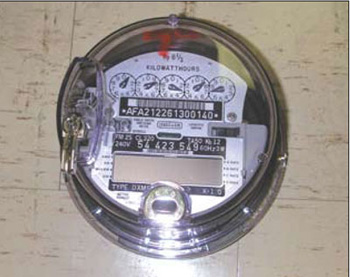
Photo 1. Residential Meter
I understand that most customers have chosen to have the same utility for both functions. If utilities other than your service utility offer supply in your state, compare the supply charges of the two utilities. You might be able to save some money by changing to a different supply utility.
To keep things simple in my discussion of rates, I am not going to show the delivery and supply charges separately. Imbedded in most delivery charges is a customer charge. The customer charge is usually a minimum bill associated with having electric service.
Basic Residential Rate
For our example utility, the basic residential rate has a customer charge of $7.36 per month and the total energy charge is 13.1456 cents per kWh for the summer months June through September and 14.3249 cents per kWh for the first 500kWh and 12.6017 cents per kWh for the excess over 500kWh for the winter months October through May. For this rate there is not much one can do to save money except to turn off lights and appliances when not in use. For a residence that uses 1000 kWh of energy each month, the bill would be $141.99 per month in the winter months and $138.82 per month in the summer months. The annual cost would be $1691.20 on this rate. For this rate, the supply charges are about 76% of the total bill.
Residential Electric Heat Rate
Some utilities offer a special rate for residences where the primary source of heat is electric resistance heat or electric heat pump. For our example utility, the customer charge for this rate is $7.36 per month and total energy charge is 14.1284 cents per KWh for the summer months June through September, and 15.5948 cents per kWh for the first 500kWh and 8.6716 cents per kWh for the excess over 500kWh for the winter months October through May. Obviously, the big savings in this rate is the 8.6716 cents per kWh for the winter months. For a residence that uses 1000 kWh each month in the summer months and 2000 kWh per month in the winter
months, the annual cost would be $2317.86 on this rate. If the customer originally had oil or gas heat and then switched to electric heat but did not notify the electric utility to change them to the electric heat rate, the annual cost would be $2699.34 on the basic residential rate. I have heard of customers paying the higher rate for years before they realized their error. I am sure there are customers who still pay the higher rate.
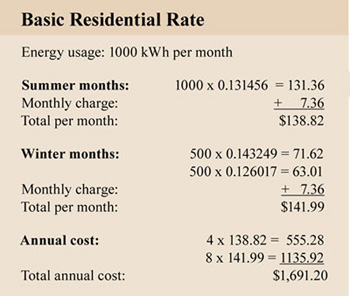
Table 1. Basic Residential Rate
Residential Time-of-Use Rate
Some utilities offer a rate where the cost of energy changes with the time of day. For our example utility, the customer charge for this rate is $11.32 per month and the energy charge during the summer months is 22.8253 cents per kWh during on-peak hours of the day and 6.58390 cents per kWh during off-peak hours of the day. On-peak hours are 9:00 a. m. to 8:00 p. m. Monday through Friday. During Daylight Savings Time, on-peak hours are 10:00 a. m. to 9:00 p. m. Monday through Friday. During the winter months, the energy charge is 22.7142 cents per kWh during on-peak hours of the day and 7.6336 cents per kWh during off-peak hours of the day. To accomplish the metering function for this rate, the utility installs a sophisticated electronic meter that has a built-in computer. The computer has a very accurate clock and keeps track of how much energy is used during the on-peak and off-peak time periods of each day.
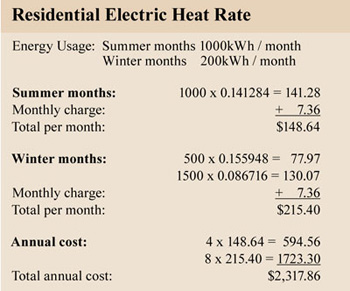
Table 2. Residential Electric Heat Rate
Note the huge price difference between on-peak and off-peak charges. If your work schedule is such that you are only home from 8:00 p. m. to 9:00 a. m. and you turn off your heat (winter) and air-conditioning (summer) when you are not home, you could save a bundle. If you get home at 6 p. m., the savings may not be as much, particularly if you use an electric stove. On the weekend, you do not have to change your lifestyle since you are on the cheap rate all weekend.
Residential Time-of-Use With Demand Rate
Some utilities offer a time-of-use rate where the customer is charged for energy and demand. You will recall from part one, peak demand is the peak power and is based upon the maximum instantaneous current.
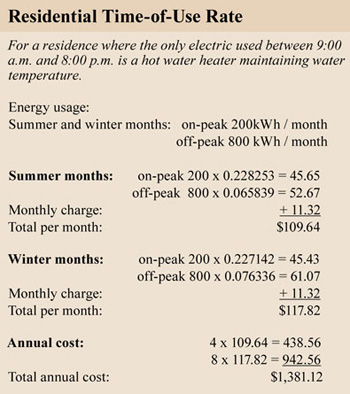
Table 3. Residential Time-of-Use Rate
A family comes home from the beach on a hot summer day. Mom turns on the air-conditioner because the house is hot. Dad goes to the refrigerator and chest freezer and stands there with the door open for five minutes trying to decide what to cook for supper. Both units turn on. Dad turns on the oven and two burners of the electric stove to cook supper. Oldest daughter jumps into the shower. The electric hot water heater turns on. Mom throws most of the beach clothes into the washing machine. The son decides to dry his beach towels without washing them. Now the electric clothes dryer is on. Oldest daughter gets out of the shower and finds cold air coming out of the air-conditioner vent. She turns on the electric wall heater in the bathroom while she dries her hair with a hair dryer the size of a chain saw.
Would you believe 100 amps at 240 volts? That is 24,000 Watts (24 kW) peak demand. Since a 60-minute demand is the average power used for a 60 minutes period and it is not likely that all the appliances would be on for a full hour, the 60-minute demand will probably be less. That may not be true if you have six teenagers.
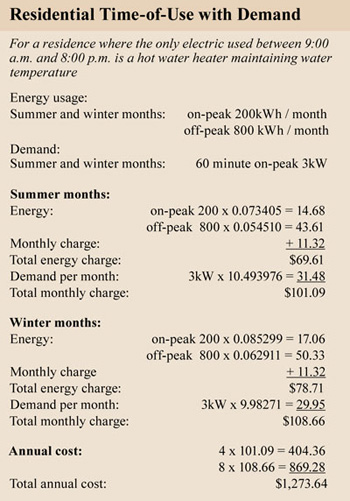
Table 4. Residential Time-of-Use with Demand
For our example utility, the customer charge for this rate is $11.32 per month and the energy charge during the summer months is 7.3405 cents per kWh during on-peak hours of the day and 5.4510 cents per kWh during off-peak hours of the day. For this rate, on-peak hours are 8:00 a. m. to 9:00 p.m Monday through Friday. During Daylight Savings Time, onpeak hours are 9:00 a. m. to 10:00 p. m. Monday through Friday. During the winter months, the energy charge is 8.5299 cents per kWh during on-peak hours of the day and 6.2911 cents per kWh during off-peak hours of the day. The demand charge is $10.493976 per kW during the summer months and $9.982711 per kW during winter months.
The billing demand during the summer months is the greatest demand established during any 60-minute clock hour of the month, during on-peak hours, taken to the nearest whole kW. The billing demand for each of the winter months is the greater of the maximum demand established during any 60-minute clock hour of the month, during on-peak hours, taken to the nearest whole kW or 75% of the greatest billing demand as created during the most recent summer billing months.
It is easy to see that the energy charges are low for this rate but the demand charge can kill you. At $10.49 per kW, this rate might not be a good choice for the family who goes to the beach each month. I think that the complexity of this rate is one reason why very few people switch to this rate. As I suggested with the nondemand time-of-use rate, if you are only home between 8 p. m. and 9 a. m. each day this rate might save you a lot of money.
Next time, in Part 3, I will get into the details of the rates that apply to commercial and industrial facilities.










Find Us on Socials